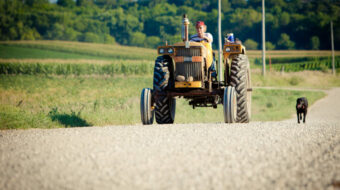The five reactionary Supreme Court judges ignored evidence and ruled to let stand the results of a 2003 firefighter promotion test, even though no African Americans were promoted, and despite the fact that second-generation fire fighters, mostly white, had test material that the others did not possess. In their ruling, the ultra-conservative judges ignored flaws in the testing, past discrimination in New Haven, and a fundamental remedy for inequality. Their ruling, though logically and morally repugnant, was not surprising.
Writing in dissent, Justice Ruth Bader Ginsburg agreed that test material was unfairly made available and that the test had irrelevant questions. A number of the examination questions, according to testimony, “were not germane to New Haven’s practices and procedures. At least two candidates reported unequal access to study materials. Some of the candidates had the necessary books “even before the syllabus was issued.” Others had to invest substantial sums to purchase the materials and “wait a month and a half for some of the books because they were on back order.” Justice Ginsburg pointed out that the disparities fell along racial lines: “While many Caucasian applicants could obtain materials and assistance from relatives in the fire service, the overwhelming majority of minority applicants were ‘first-generation’ firefighters without such support networks.” In addition, she wrote, “People good at taking tests were not necessarily the best leaders in public safety emergencies.” “… The disparity in results should have been examined.” She concluded that white firefighters “had no vested right to promotion.”
Judge Ginsburg also argued that “there was a long history of race discrimination in firefighting.” According to NAACP testimony, “Many fire departments refused to hire African Americans before the late 1950s or 1960s, and those willing to hire African Americans only did so in rare instances, assigned them to segregated firehouses, and subjected them to severe harassment.”
As of 2003, only one of New Haven’s 21 fire captains was African American. The NAACP charges, “New Haven has yet to eliminate the effects of entrenched racially discriminatory practices in its fire department.” The majority decision failed to consider the reality that “barriers to equal employment are greater in police and fire departments than in any other area of state and local government.
In addition to the evidence and history, the majority decision disregarded the value of affirmative action programs and their necessity for functioning democracy. The AFL-CIO calls affirmative action “a commonsense approach to addressing the nation’s long and sad history of discrimination through special outreach to those who have been excluded because of race, gender and national origin.”
The labor federation statement continues, “We will promote and defend it as one of the best and most effective strategies available to move us in the direction of an inclusive and equal society.” Because discrimination reduces wages and benefits even for white workers, all workers have a stake in affirmative action programs. Even if there were no test material advantages and even if every test question were relevant, Affirmative action takes precedence.
Rather than calling for a new test to determine qualifications, Justice Anthony Kennedy, writing for the court majority, claimed that the white firefighters were victims of “disparate treatment.” In rebuttal, Justice Blackman said, “In arriving at its order, the Court barely acknowledges the path marking decision in Griggs v. Duke Power Co. (a 1971 court case), which explained the centrality of the disparate-impact concept to effective enforcement of Title VII. The Court’s order and opinion, I anticipate, will not have staying power.”
In this decision, as in many others, Justice Anthony Kennedy, writing for the majority, not only ignored the flawed test, discrimination in the recent past, and the use of a new test that would determine qualifications. Justice Kennedy also rejected the use of quotas, even though affirmative action, one of the ways of bringing about justice and equality, needs quotas to work effectively. Without considering quotas, the cases often are decided according to intent, a concept that is very difficult to prove, and, as in the New Haven case, did not exist (There is no evidence that the city intended to discriminate). Quotas under affirmative action do not preclude others; the program does insist that percentages of qualified applicants be fair.
It is a violation of affirmative action to favor the unqualified. Those who charge that affirmative action favors the unqualified tell falsehoods, and, instead, support the drive for racism that continues, mainly because racism brings hundreds of billions in super-profits for Wall Street. The right wing on the court has a history of silently defending those profits.
The vote of the five most conservative judges was in line with their previous statements against affirmative action. Anthony Kennedy, a Reagan appointee, opposed affirmative action “as promoting stereotypes of minorities.” Antonin Scalia called affirmative action “the most evil fruit of a fundamentally bad seed.” Clarence Thomas told the National Bar Association in 1998 that he intended to continue to oppose affirmative action and hold fast to other conservative views. The Legal Defense Fund said that Samuel Alito’s record on affirmative action was “extremely troubling.” Alito was directly involved in the Reagan administration’s frontal attack on affirmative action. As an adviser to President Reagan, Chief Justice John Roberts said that affirmative action programs were “highly objectionable.”
Kennedy and Scalia were appointed by President Reagan, Thomas by the first President Bush. Both Reagan and Bush were ardent opponents of affirmative action. President George W. Bush appointed Roberts and Alito. The AFL-CIO called the Bush administration “an avowed foe of affirmative action and any law that helps working Americans.”









